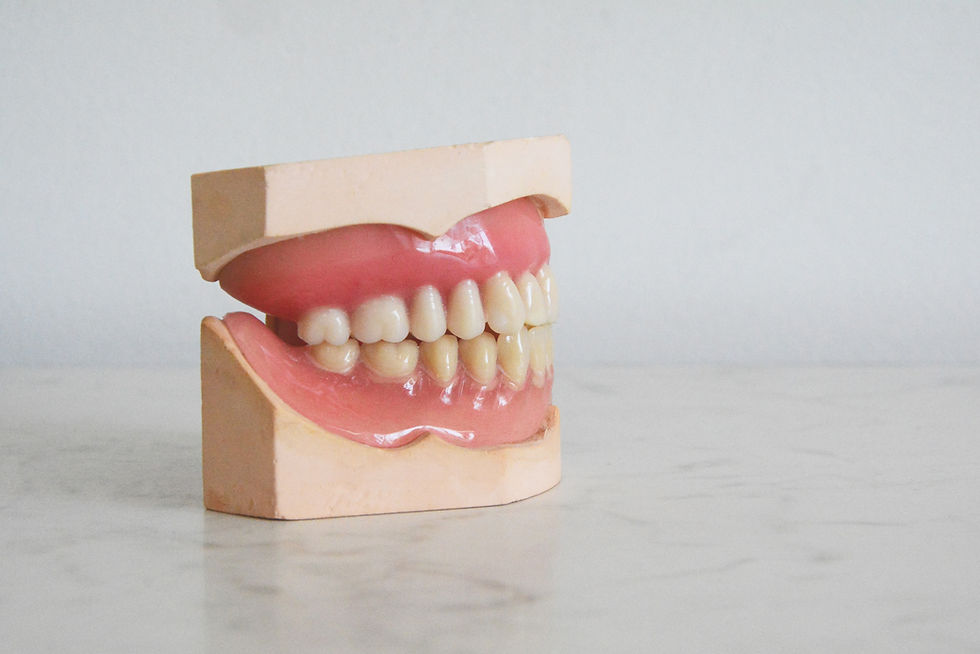How To Brush Your Teeth
- reception103
- Jan 13, 2021
- 3 min read
The brushing process seems simple enough, however there is actually an art to doing it well! We recommend that you brush twice a day for two minutes.
There are four main areas that need to be cleaned when brushing your teeth:
The outside tooth surfaces (next to your cheeks)
The chewing surfaces
The inside tooth surfaces (next to your tongue)
Your tongue
When brushing the inside and outside surfaces of your teeth we recommend you hold your toothbrush at a 45 degree angle and brush in small circular motions, ensuring that the edge of your toothbrush reaches the gum-line as this is a common area for plaque build-up.
To brush your chewing surfaces and tongue, we recommend you use short gentle brush strokes backwards and forwards. You can tilt your toothbrush slightly so that the edge of the brush reaches into the deeper crevices of your molar teeth.
For some people brushing all the tooth surfaces using a backwards and forwards motion feels more comfortable. This is not the preferred brushing technique because it can cause a lot of scraping along the gum-line which could lead to gum recession and tooth sensitivity. If you are experiencing these symptoms then please talk to us!
Some people feel that to clean their teeth effectively they need to apply a lot of pressure and brush quite hard. This is not true. If you are using a good brushing technique then you only need to brush gently. Brushing too hard can lead to gum recession, so try and avoid it if you can.
WHAT TOOTHPASTE TO USE? At HBA, we recommend the use of fluoridated toothpaste. This is because of the well-documented effects of fluoride in preventing tooth decay. There are many good toothpaste options on the market – deciding which one to use can be overwhelming. Individual toothpastes are often designed to assist with particular aspects of dental health such as whitening, gum disease and sensitivity-just to name a few. It is your choice as to what toothpaste you feel is best for you. However, if you would like some guidance we are happy to recommend a toothpaste that would be most appropriate for you after formally assessing your oral health needs.
Remember, you only need a pea-sized amount of toothpaste to effectively clean your teeth!
IS A MANUAL OR ELECTRIC TOOTHBRUSH BETTER? If used properly, both types of brushes will provide a thorough level of cleanliness. Neither is better than the other – the decision of which toothbrush to use depends on your personal preference!
Manual Toothbrush
We advise our patients to use a soft bristled toothbrush with a small head. This is because the medium to hard bristled toothbrushes are known to cause gum trauma or wear the enamel away from your teeth, especially near the gum-line. Also the small bristles are useful in getting to those hard to reach areas (like wisdom teeth).
Electric Toothbrush
An electric or battery operated toothbrush can be particularly helpful to access difficult areas due to its small size and powerful cleaning ability. On average, a toothbrush should be changed every three months or when it shows signs of wear. If you are changing the brush more often than this, then chances are you may be brushing too hard.
For any further information, please feel free to contact the team at HBA Dental Centre
DO I NEED TO BRUSH MY BABY’S TEETH? Yes! You will need to start brushing your baby’s teeth from the time they erupt (generally around six months of age).
Using a very soft baby toothbrush, brush the teeth gently morning and night. You do not need to use toothpaste at this young age – just water will be enough to clean the teeth.
At around 12 months of age, you can start using baby toothpaste. You only need a tiny amount of toothpaste – about the size of a grain of rice. Because you are using such a small amount you do not need to worry about rinsing after brushing.
Babies and young children generally find it fun to chew on the toothbrush which is a part of helping them learn about brushing – but it can mean that you will need to regularly replace your child’s toothbrush as soon as you notice any wear.


